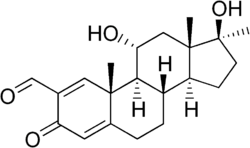Formebolone
 | |
 | |
| Clinical data | |
|---|---|
| Trade names | Esiclene, Hubernol, Metanor |
| Routes of administration | Oral |
| Identifiers | |
| |
| Synonyms | Formyldienolone; 2-Formyl-11α-hydroxy-17α-methyl-δ1-testosterone |
| CAS Number |
2454-11-7 |
| PubChem (CID) | 17150 |
| ChemSpider |
16234 |
| UNII |
Z2MMV08KUQ |
| ChEMBL |
CHEMBL2107419 |
| Chemical and physical data | |
| Formula | C21H28O4 |
| Molar mass | 344.44 g/mol |
| 3D model (Jmol) | Interactive image |
| |
| |
| | |
Formebolone (INN, BAN) (brand names Esiclene, Hubernol, Metanor), also known (confusingly) as formyldienolone, as well as 2-formyl-11α-hydroxy-17α-methyl-δ1-testosterone, is an orally active anabolic-androgenic steroid (AAS) described as an anticatabolic and anabolic drug that is or has been marketed in Spain and Italy.[1][2][3] As an AAS, it shows some anabolic activity, though it is inferior to testosterone in terms of potency, but is said to have virtually no androgenic activity.[4] Formebolone counteracts the catabolic effects (control of nitrogen balance) of potent glucocorticoids like dexamethasone phosphate.[4][5] A close analogue, roxibolone (and its long-acting ester variant decylroxibolone), shows similar antiglucocorticoid activity to formebolone but, in contrast, is devoid of activity as an AAS.[6]
Roxibolone has been found not to bind to the glucocorticoid receptor, and it has been suggested that the antiglucocorticoid activity of roxibolone and formebolone may instead be mediated by modulation of enzymatic processes.[7] Indeed, 11α- and 11β-hydroxyprogesterone (formebolone and roxibolone being 11α- and 11β-hydroxylated (respectively) similarly) are known to be potent inhibitors of 11β-hydroxysteroid dehydrogenase (11β-HSD), which is responsible for the biosynthesis of the potent endogenous glucocorticoids cortisol and corticosterone (from the precursors deoxycortisol and deoxycorticosterone, respectively).[8][9] However, formebolone was found to be a very weak inhibitor of 11β-HSD type 2 (IC50 > 10 μM), although it should be mentioned that this specific isoenzyme of 11β-HSD is responsible for the inactivation of glucocorticoids rather than their production.[10]
References
- ↑ Index Nominum 2000: International Drug Directory. Taylor & Francis. January 2000. pp. 471–. ISBN 978-3-88763-075-1.
- ↑ J. Elks (14 November 2014). The Dictionary of Drugs: Chemical Data: Chemical Data, Structures and Bibliographies. Springer. pp. 577–. ISBN 978-1-4757-2085-3.
- ↑ I.K. Morton; Judith M. Hall (31 October 1999). Concise Dictionary of Pharmacological Agents: Properties and Synonyms. Springer Science & Business Media. pp. 125–. ISBN 978-0-7514-0499-9.
- 1 2 Gelli D, Vignati E (1976). "Metabolic studies with formebolone (2-formyl-17 (alpha)-methyl-androsta-1,4-diene-11 (alpha), 17 (beta)-diol-3-one) in humans". J. Int. Med. Res. 4 (2): 96–105. PMID 799985.
- ↑ Cerutti S, Forlani A, Galimberti E (1976). "Anticatabolic action of formebolone in the castrated rat treated with dexamethasone". Arzneimittelforschung. 26 (9): 1673–7. PMID 1036699.
- ↑ Felippone F, Resnati G, Scolastico C, Tronconi G (1984). "Synthesis of 2-carboxy-11 beta, 17 beta-dihydroxy-17-methyl-1, 4-androstadien-3-one and related compounds". Steroids. 43 (3): 271–82. PMID 6523544.
- ↑ Dahlberg E, Snochowski M, Gustafsson JA (1981). "Regulation of the androgen and glucocorticoid receptors in rat and mouse skeletal muscle cytosol". Endocrinology. 108 (4): 1431–40. doi:10.1210/endo-108-4-1431. PMID 6970661.
- ↑ Souness GW, Latif SA, Laurenzo JL, Morris DJ (1995). "11 alpha- and 11 beta-hydroxyprogesterone, potent inhibitors of 11 beta-hydroxysteroid dehydrogenase (isoforms 1 and 2), confer marked mineralocorticoid activity on corticosterone in the ADX rat". Endocrinology. 136 (4): 1809–12. doi:10.1210/endo.136.4.7895695. PMID 7895695.
- ↑ Souness GW, Morris DJ (1996). "11 alpha- and 11 beta-hydroxyprogesterone, potent inhibitors of 11 beta-hydroxysteroid dehydrogenase, possess hypertensinogenic activity in the rat". Hypertension. 27 (3 Pt 1): 421–5. PMID 8698448.
- ↑ Fürstenberger C, Vuorinen A, Da Cunha T, Kratschmar DV, Saugy M, Schuster D, Odermatt A (2012). "The anabolic androgenic steroid fluoxymesterone inhibits 11β-hydroxysteroid dehydrogenase 2-dependent glucocorticoid inactivation". Toxicol. Sci. 126 (2): 353–61. doi:10.1093/toxsci/kfs022. PMID 22273746.